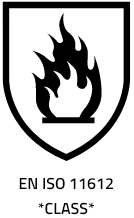EN ISO 11612
Protective clothing - Clothing to protect against heat and flame - Minimum performance requirements
EN ISO 11612 specifies performance requirements for protective clothing made from flexible materials, which are designed to protect the wearer’s body, except the hands, from heat and/or flame. For protection of the wearer’s head and feet, the only items of protective clothing falling within the scope of EN ISO 11612 are gaiters, 
The performance requirements set out in EN ISO 11612 are applicable to protective clothing which could be worn for a wide range of end uses, where there is a need for clothing with limited flame spread properties and where the user can be exposed to radiant or convective or contact heat or to molten metal splashes.
Classes
For all end-uses, the minimum performance requirement shall be at least one of the heat transmission performance code letters, i.e. code letter B, code letter C, code letter D, code letter E, or code letter F, in addition to the obligatory minimum performance requirements, code letter A. The application of the performance requirements of this Clause will be relevant according to the intended use claimed by the manufacturer for the clothing.
All clothing with EN ISO 11612 meet at least A1 or A2 requirements.
A2:
Advanced limited flame spread.
No flaming or molten debris.
Afterglow time shall be less than 2 seconds.
Afterflame time shall be less than 2 seconds.
A1:
All of the properties from A2 +
No holes larger than 5mm in any direction will form.
When tested in accordance with ISO 9151, single-layer or multilayer garments and/or clothing assemblies
that are claimed to offer protection against convective heat shall meet at least performance level B1 (see below). If the garment is multi-layered, the test shall be carried out on the complete material assembly
with the innermost layer facing the calorimeter and the outermost layer facing the energy source.
B1: from 4 to 10 seconds
B2: from 10 to 20 seconds
B3: 20 seconds and more
When tested in accordance with ISO 6942, Method B, at a heat flux density of 20 kW/m2, single-layer
or multilayer garments and/or clothing assemblies that are claimed to offer protection against radiant
heat shall meet at least performance level C1 (see below).
Tests on metallized materials shall be carried
out after pre-treatment as specified in Annex A. For multi-layered garments, the test shall be carried out
on the complete material assembly with the innermost layer facing the calorimeter and the outermost
layer facing the energy source.
C1: from 7 to 20 seconds
C2: from 20 to 50 seconds
C3: from 50 to 95 seconds
C4: 95 seconds and more
When tested in accordance with ISO 9185 using molten aluminium, single layer or multilayer garments
and/or clothing assemblies that are claimed to offer protection against molten aluminium splash shall
meet at least performance level D1 (see below).
D1: between 100 and 200 grams
D2: between 200 and 350 grams
D3: 350 grams and more
When tested in accordance with ISO 9185 using molten iron, single-layer or multilayer garments and/or
clothing assemblies that are claimed to offer protection against molten iron splash shall meet at least
performance level E1 (see below).
E1: between 60 and 120 grams
E2: between 120 and 200 grams
E3: 200 grams and more
When tested in accordance with ISO 12127-1 at a temperature of 250 °C, single-layer or multilayer
garments and/or clothing assemblies that are claimed to offer protection against contact heat shall meet
at least performance level F1 (see below).
F1: between 5.0 and less than 10.0 seconds
F2: between 10.0 and less than 15.0 seconds
F3: 15.0 seconds and more
Looking for safety wear that reach these norms?











